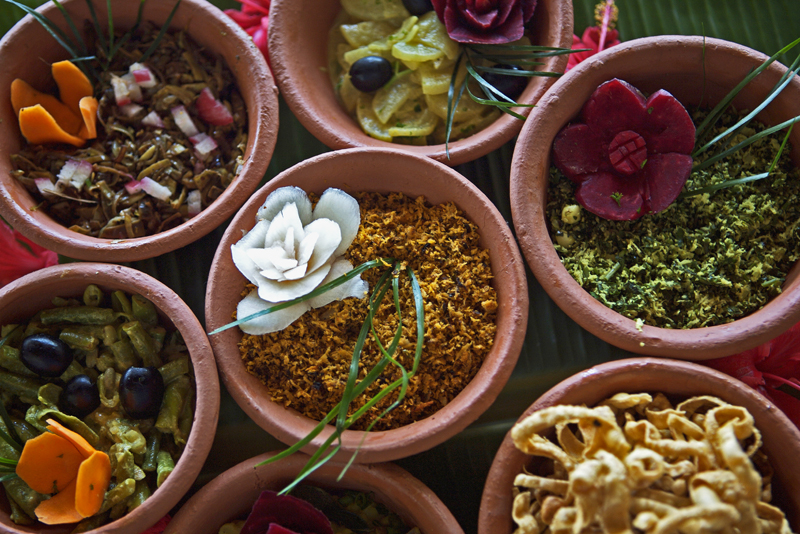Ayurveda has found its way to our Instagram feeds, bathroom counters and tea shelves. But does Ayurvedic simply equal healthiness, zen and bliss? We investigated what is behind the Sanskrit word with the help of established practitioners and experts. Ayurveda, a sister science of yoga, appeals to seekers of holistic wellbeing, by its addressing of physical, mental, emotional, and spiritual needs.
Words: Meri Frig
Image: Paragonsrilanka.com
The word Ayurveda seems to be everywhere: when exploring the Pukka tea collection, in natural cosmetics, the wellbeing blogs we follow. The Yogi Women’s Energy tea promotes itself as an Ayurvedic blend. Urban Veda natural skincare ranges are designed to be suited to different skincare types based on the Ayurvedic knowledge. In Dubai, people are queuing to grab their Go Organic Ayurvedic Juice Detox. Health shops are stocking up ghee and friends are sharing kitchari recipes.
Image: Onegreenplanet.org
Ayurveda promises guidance to a healthy and happy life. Yet where does the secret lie? According to the ancient wisdom, there are three basic types of energy, called doshas, that are present in everyone: vata, pitta and kapha. Each of them have specific characteristics and tendencies. Ayurveda improves health and wellbeing by seeking and maintaining balance: balance of the body, mind, and consciousness can be created by finding balance in one’s own individual constitution.
Image: Med-shkola.ru
The Ayurvedic Institute informs us that the basic qualities of vata, for example, are dry, light, cold, rough, subtle, and mobile. In excess, they may cause imbalance: frequent travel, loud noises, continual stimulation, or exposure to cold derange vata. Vata can be balanced by keeping warm, having warm meals, getting plenty of rest, and having daily routines.
Typical pitta attributes, then, are oily, hot, light, and mobile. For example, pitta types are more prone to suffer from heat and short tempers, and to balance, they need to avoid excessive heat and enjoy cooler meals and climates.
Image: Ahmisawellness.org
The main qualities of kapha are unctuous, cool, heavy, slow, smooth, soft, and stable. Kapha types tend to be grounded and calm. They are easily attracted to sweet, salty and oily foods and may gain weight easily. To balance, they need to get plenty of exercise, keep active, and eat light.
Typically, one dosha is predominant in one’s constitution. Lifestyle and diet choices may be adopted to pacify it to regain a healthy balance. In fact, anything from herbs to smells and environments influence our constitution and can function as Ayurvedic medicine. Besides our natural constitution, factors such as our emotional state, diet and food choices, seasons and weather, as well as relationships may disturb this balance.
Image: Munatycooking.com
Your own Ayurvedic profile can be discovered rather quickly on, for example, by taking a quiz on the Banyan Botanicals website. But there are many Ayurvedic practitioners and therapists that offer individual guidance towards better health and wellbeing. We asked three Ayurvedic experts some questions that puzzled us: How have they helped people with Ayurveda? Why is it such as big trend at the moment?
1. Mandi, Surya Ayurveda (Helsinki, Finland)
An increasing number of Finns have different impediments of which even extensive medical examinations cannot find causes. Different intestine problems are such, for instance. For example, we have helped our customers with different kinds of lifestyle illnesses.
Ayurveda is trendy at the moment because it always considers people in their entirety, but also as unique individuals. The treatments are natural and they emphasise the value of listening to your own body – this is where we go back to the origins. People have been running after different diets and do not necessarily recognise anymore what is best for oneself. What do you do if some food ingredient, no matter how healthy, just does not suit you?
Here is what one of our customers wrote:
“I got answers to questions I had been pondering for a long time. When checking the food ingredients that suit me according to Ayurvedic knowledge, I noticed that previous healthier eating had not necessarily been good for me… First, it felt impossible to favour a vegetarian diet. It won’t work, I thought. Despite everything, I thought, why not give it a try?
I felt intense gratitude for having been directed towards a better life. I was delighted to see symptoms disappear with time and I was happier than in years. No more drugs, food is our medicine, nothing else is needed. Food can also be poison that slowly, but surely destroys our body. I only now understand how different foods impact my body.”
2. Sandra Aumiller, The Ayurvedic Institute (Albuquerque, United States)
Most people come to Ayurveda, when they are no longer getting results from the mainstream medical model. Often, the simple act of improving a person’s digestion, which in turn creates balance in the body and improves the immune system, begins to change the overall balance of a person. Real change can happen when the biological needs are met. This has been the case with people who have had chronic problems with skin issues i.e.: psoriasis, eczema, boils, rashes; MS, infertility, hypoglycemia, and ageing symptoms.
Why do I think Ayurveda is such a big trend at the moment? In one word: yoga. Yoga has increased at a tremendous rate in the last forty years. In 1971, it was difficult to find classes or instructors, and now there are numerous forms available to people throughout the world, in even very small communities and remote places. The practice is, at its roots, the sister science of Ayurveda. The increase of awareness that comes from the practice of Yoga begins the search for well-being at the cellular level. Ayurveda makes sense to those, who have changed their consciousness and who are seeking a medical model that addresses all aspects of the physical, mental, emotional and spiritual needs of living in the body. The medical profession and pharmaceutical industry operate from the theory that thousands of separate illnesses exist, whose symptoms can be treated or suppressed by ingesting synthetic compounds. Ayurveda, on the other hand, believes that only imbalance exists, and once that is treated or changed at the root level, all symptoms, and all illness is eliminated.
The most rewarding feedback I receive is when the client’s issues are resolved and they are educated to the point of maintaining a balance on all levels of their life including, physical, social, vocation, relationships, etc. The biggest compliment I receive is when they no longer need me and they are leading what I call a big life by feeling connected to the world with love, light and justice.
3. Dr. Deepa Apté, Ayurveda Pura (London, United Kingdom)
I have been fortunate enough with my background in conventional medicine and Ayurveda, that I have been able to help people. I get clients from all kind of medical background, be it stress to more serious ailments like thyroid, multiple sclerosis etc. And in all these instances, Ayurveda has been a huge help to them.
I prefer to look at Ayurveda not as a trend, but a holistic science that will stay for a long time. Decades ago, with the advent of Yoga to the west, many people looked at it as a trend, but today after so many years, Yoga is becoming ever more popular due to its health benefits. Likewise, Ayurveda, which is a sister science of Yoga also portrays many health benefits.
Ayurveda is a complete way of life. It is prevention-oriented, it is free from harmful side-effects and treats the root cause of a disease, rather than just the symptoms. Ayurveda views illness as caused by an imbalance in a person’s physical or mental constitution, and therefore seeks to gently bring a person’s body back into a healthy balance. Ayurveda is not just for people who are ill, but also for healthy individuals, because use of Ayurvedic techniques maintains good health. And because of the above-mentioned reasons, Ayurveda has become quite well known in today’s environment.
I have been fortunate that most of my clients have seen huge successes through following Ayurveda. One of the best rewards for me, even as a teacher (I run an Ayurvedic Academy to training people to become Ayurvedic Practitioners and Therapists) is to see many of my clients take up Ayurvedic studies to become Ayurvedic therapists or consultants, so that they can help people through Ayurveda, just the way Ayurveda has helped them.




